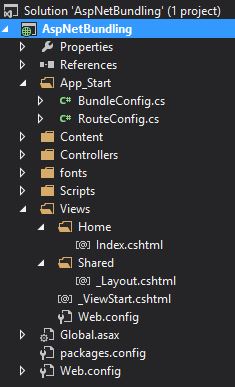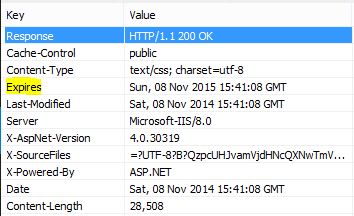ASP.NET is a technology stack that has earned a reputation in enhancing productivity. With the release of ASP.NET 4.5, the stack has pushed the envelope by adding automated bundling of web resources, making it easy and flexible to work with.
In this article, I would like to take a look at bundling in ASP.NET. I’ll explore how seamless it is to set up bundling in any ASP.NET project.
With ASP.NET 4.5, the framework has gained a new namespace called System.Web.Optimization. Let’s see how this works.
Key Takeaways
- ASP.NET 4.5 has added automated bundling of web resources, making it easier to manage and work with them. This is achieved through the new namespace called System.Web.Optimization, which provides the tooling to automate managing web resources.
- Bundling in ASP.NET improves performance by reducing the number of HTTP requests, as these are expensive and can slow down the application. This is particularly beneficial for applications with numerous script and style files. Bundling also enables caching of resources in the browser for about one year, further improving performance.
- Implementing bundling in an ASP.NET application involves creating a BundleConfig class in the App_Start folder, where specific bundles are defined. Once defined, these bundles can be rendered anywhere in the application. It’s also possible to control the order of files in a bundle, which is useful when certain files depend on others and need to be loaded in a specific order.
Setup
For this tutorial, I am starting out with an empty ASP.NET MVC project. This way, I can focus on what it takes to get automated bundling set up. The same basic steps also apply to WebForms. I will use Razor and C# for this tutorial.
After clicking through prompts for a new project, add these packages in the NuGet Package Manager Console:
PM> Install-Package Microsoft.AspNet.Mvc
PM> Install-Package jQuery
PM> Install-Package Bootstrap
PM> Install-Package Microsoft.AspNet.Optimization
I would like you to pay attention to the NuGet package called Microsoft.AspNet.Optimization. If you are working off an existing ASP.NET project, this NuGet package makes your job easy. After it gets installed, all you have to do is set up the rest of the plumbing.
With the web optimization framework, you get the tooling to automate managing web resources. You may find the official documentation at MSDN.
Now, add a folder named App_Start in your main solution if you don’t have it already. We need to get bundling set up by adding this static class.
public class BundleConfig
{
public static void RegisterBundles(BundleCollection bundles)
{
}
}
Routing is set up with any existing project so I will not be including it in this tutorial.
To let the ASP.NET framework know about our newly configured bundles, do this in the Global.asax:
public class Global : HttpApplication
{
protected void Application_Start(object sender, EventArgs e)
{
BundleConfig.RegisterBundles(BundleTable.Bundles);
}
}
ASP.NET is an event-driven framework. If you can imagine, the IIS server sits idle, waiting for events. In this case it would be client browser requests through HTTP. When your application first fires up, ASP.NET calls Application_Start in Global.asax. Inside Application_Start, is where you get to come in and set up the specific bundles you want to use in your application.
At the end, my solution is set up this way:

Watch the traffic
It is time to add bundles and see how it plays out inside the browser. Add this to BundleConfig which is the static class I specified above:
public class BundleConfig
{
public static void RegisterBundles(BundleCollection bundles)
{
bundles.Add(new StyleBundle("~/bundle/bootstrap-styles")
.Include("~/Content/bootstrap.css")
.Include("~/Content/bootstrap-theme.css")
.Include("~/Content/Site.css"));
bundles.Add(new StyleBundle("~/bundle/Home/Index-styles")
.Include("~/Content/StyleSheet1.css")
.Include("~/Content/StyleSheet2.css")
.Include("~/Content/StyleSheet3.css"));
bundles.Add(new ScriptBundle("~/bundle/bootstrap-scripts")
.Include("~/Scripts/bootstrap.js")
.Include("~/Scripts/jquery-{version}.js")
.Include("~/Scripts/modernizr-{version}.js"));
bundles.Add(new ScriptBundle("~/bundle/Home/Index-scripts")
.Include("~/Scripts/JavaScript1.js")
.Include("~/Scripts/JavaScript2.js")
.Include("~/Scripts/JavaScript3.js"));
}
}
Your specific needs will be different. The method above takes in a BundleCollection as a parameter. Notice, this is the BundleTable.Bundles coming from Global.asax. Then, I craft both style and script bundles to suit my specific needs.
I use the {version} wildcard to tell the bundling engine to grab any version of jQuery that happens to be in my solution. In the Release configuration jQuery .min.js gets added to the bundle, but not in Debug. This gives me flexibility in my development environment when working with jQuery. I can swap out different versions of jQuery and my bundling setup will not care. This same wildcard technique applies to any other client-side library.
Because I get to make up my own bundles, I can tailor resources I need for specific screens.
I placed the ~/bundle/bootstrap-styles and ~/bundle/bootstrap-scripts bundles inside the _Layout.cshtml master page. Since it is verbose with a lot of bootstrap plumbing, I’ll omit it from this tutorial.
Here is what my Index.cshtml Razor page looks like:
@{
ViewBag.Title = "Index";
}
@Styles.Render("~/bundle/Home/Index-styles")
<h2>Hello World</h2>
<p>
Be sure to check out glyphs like these:
<span class="glyphicon glyphicon-plus"></span>.
</p>
@Scripts.Render("~/bundle/Home/Index-scripts")
Easy. Once bundles get defined, I get to put them anywhere I need in my application. I’m following a simple convention of {Controller}/{Action} to define bundles. You may wish to do the same.
If you find that you get Razor page errors because it can’t find Styles.Render or Scripts.Render. Make sure to include this in your Web.config that’s inside the Views folder.
<system.web.webPages.razor>
...
<pages pageBaseType="System.Web.Mvc.WebViewPage">
<namespaces>
...
<add namespace="System.Web.Optimization"/>
</namespaces>
</pages>
</system.web.webPages.razor>
</system.web.webPages.razor>
This tells the Razor engine to include the System.Web.Optimization namespace when rendering dynamic HTML. You may also include any other namespace you need for your specific project. This will save you from having to fully-qualify each Razor extension.
With all this, let’s see the network traffic:

Red means the browser sits idle. Yellow is the time the browser takes to make a request. Blue is the time it takes to get a response from the server. With most modern browsers, you can do about six requests per domain at a time. If you need more than six, the browser gets to wait. The request at the very top is the dynamic HTML I must get from the server.
Why does this matter?
To use an analogy, you can think of your back-end C# programming language as a spaceship. You get speed and time-warping capabilities when you travel. As long as your back-end runs local on your server you can assume high performance. But, when the request pipeline hits HTTP it is a completely different story.
I’d like to think of the HTTP network protocol as a mule cart. No matter how much optimization you do on the back-end, you can always rely on the fact that HTTP is slow. So, just like a mule cart, it is good to load it up with plenty of provisions before sending it across town. Round-tripping the server over and over is a sure way to kill performance.
HTTP requests are expensive. Your primary objective is to reduce the number of round trips you do over HTTP.
Enabling
To turn on bundling in the framework, all you need to do is change the Web.config in your solution folder.
<compilation debug="false" targetFramework="4.5" />
You may also hard code it with:
BundleTable.EnableOptimizations = true;
When you hard code it in C#, this takes precedence over the Web.config. In a typical setup you can use a Web.config transformation to enable it in Release mode. There is no need to attempt to debug minified JavaScript code.
Let’s see the bundled traffic:

Beautiful. Resources start loading as soon as the dynamic HTML gets loaded. Here, I take full advantage of the browser capability since I have exactly six resources. Notice the last resource doesn’t start until all other resources get rendered. This is because it is a web font, and it originates from a CSS bundle.
Caching
When bundling gets turned on, an added bonus is resources get cached in the browser for about one year. If your resources change before that, the query string appended to the end will change. This will, in effect, expire any resources the browser no longer needs. This is often referred to as cache busting.
For example, this is what our bundled resources look like:
/bundle/bootstrap-styles?v=epi1k_G4Tsd0o4dXIOJcBg5gefY7ieCSx0AUDxqm78U1
/bundle/Home/Index-styles?v=uxFDb5XiuKadZOyd2DKyzUU-mh3OUTNuikUDUlL7e_Q1
/bundle/Home/Index-scripts?v=Giv511fvuZRlJKLjJDPqmIxOhmtht9zFlW7lvvTMf0Y1
/bundle/bootstrap-scripts?v=j4YIBwFVDdtvOMWp63GzkWLSoYrcw0ertU_njZLALnk1
The query string appended at the end is a hash from the specific contents of each bundle. When the contents inside the bundle change, the hash appended as a query string will change too.
You may inspect the HTTP headers.

The Expires HTTP header is set to expire one year into the future.
Conclusion
ASP.NET is a cool technology designed to make your life easy. What I love the most about this is how the engine renders <link> and <style> tags for you. What I’ve always found most troubling is how these tags end up all over the place. Making it a nightmare to manage web resources.
I hope you can see how seamless it is to add automated bundling into your project. For a simple demo that demonstrates the basic technique, be sure to check out GitHub.
How have you found ASP.NET’s bundling features? Do you have any tips for improving performance?
Frequently Asked Questions (FAQs) about Bundling in ASP.NET
What is the primary purpose of bundling in ASP.NET?
Bundling in ASP.NET is a technique used to reduce the number of requests made to the server by combining multiple files into a single bundle. This process significantly improves the performance of an ASP.NET application by reducing the load time and bandwidth usage. Bundling is particularly beneficial for applications that have numerous script and style files.
How does bundling differ from minification in ASP.NET?
While both bundling and minification are used to improve the performance of an ASP.NET application, they serve different purposes. Bundling combines multiple files into one to reduce the number of server requests, while minification reduces the size of each file by eliminating unnecessary characters such as white spaces, comments, and line breaks without changing the file’s functionality.
How can I implement bundling in my ASP.NET application?
Implementing bundling in an ASP.NET application involves creating a BundleConfig class in the App_Start folder. This class contains a RegisterBundles method where you define your bundles. Each bundle is associated with a virtual path, and you can add individual files or directories to the bundle. Once the bundles are defined, you can render them in your views using the Bundles.Render method.
Can I control the order of files in a bundle?
Yes, you can control the order of files in a bundle in ASP.NET. By default, the files are ordered alphabetically. However, you can use the Include method to specify the order of files in a bundle. This is particularly useful when certain files depend on others and need to be loaded in a specific order.
What is the role of the System.Web.Optimization namespace in bundling?
The System.Web.Optimization namespace in ASP.NET provides classes and methods for bundling and minification. This namespace includes the BundleCollection class for managing bundles, the Bundle class for creating bundles, and the BundleResponse class for handling the response of a bundle request.
How does bundling affect the debugging process in ASP.NET?
Bundling can make debugging more challenging in ASP.NET because it combines multiple files into one. However, ASP.NET provides a way to disable bundling during the development stage for easier debugging. You can do this by setting the EnableOptimizations property to false in the BundleConfig class.
Can I use bundling with ASP.NET MVC?
Yes, you can use bundling with ASP.NET MVC. The process is similar to using bundling with ASP.NET Web Forms. You define your bundles in the BundleConfig class and render them in your views. However, in MVC, you typically render the bundles in the _Layout.cshtml file, which serves as a master page for the application.
Can I bundle files of different types together?
No, you cannot bundle files of different types together in ASP.NET. Each bundle should contain files of the same type. For example, you can bundle multiple CSS files together or multiple JavaScript files together, but you cannot bundle a CSS file and a JavaScript file together.
How does bundling handle versioning of files?
Bundling in ASP.NET automatically handles versioning of files. When a file in a bundle changes, ASP.NET generates a new token for the bundle, which forces the browser to download the updated bundle instead of using the cached version.
Can I use bundling with third-party libraries in ASP.NET?
Yes, you can use bundling with third-party libraries in ASP.NET. You can include the files of the third-party library in a bundle just like any other file. However, you need to ensure that the third-party library files are compatible with bundling and do not cause any issues when combined with other files.
Husband, father, and software engineer from Houston, Texas. Passionate about JavaScript and cyber-ing all the things.


